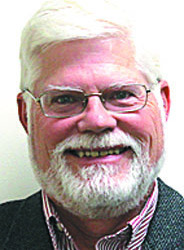Ink Spo ts Matt Paxton
The past three weeks in Washington have been described variously as chaotic and as revolutionary. I think both of these desc r ipt ions are valid. Massive changes are being promised. Entire government departments are on the chopping block. Grants programs are being upended. Thousands of government workers are being offered buy-outs.
Remember, this is what Trump promised on the campaign trail. The organizational model, straight from Elon Musk’s playbook, is to come in, make massive changes, keep what works afterward and fix what doesn’t. In the shortterm, it is chaos, but the administration seems to believe that what comes out will be a more efficient government. Time will tell.
The impact of all this on two specific programs speak to the positive and the negative fall-out over time.
First, the U.S. Agency for International Development appears headed for elimination. USAID distributes $40 billion annually in food aid, medical care, immunizations, infrastructure improvements, and clean water projects in many of the poorest countries in the world. Forty billion dollars is a lot of money, but it’s a very tiny part of the overall federal budget.
Aside from the obvious human cost to people being fed and communities being improved, there is a real cost to us from elimination of these aid programs. On the international stage, the other big player in international development, other than the UN and multinational NGOs, is China. China’s Belt and Road Initiative (BRI) is focused more on trade and economic development than direct humanitarian work. Some estimates are that China spent over $90 billion on BRI in 2023.
BRI’s projects in Asia, Africa, Europe and South America total over 200 cooperation agreements in over 150 countries. Projects include building or upgrading roads, ports, railroads, pipelines and other trade-related infrastructure. Internet connectivity and upgrades are also a part of the program. In Mozambique, for example, and BRI-funded program brought satellite TV to 1,000 villages.
The BRI is based on five priorities: policy coordination, facilities connectivity, unimpeded trade, financial integration and developing a people-to-people connection. In 2017, the Communist Party of China officially inserted the advancement of the BRI into its constitution.
If the United States abandons its outreach to Africa, Asia and South America, we risk allowing Chinese influence to grow in those areas. This would have serious implications for trade, resources and strategic alliances in the years to come.
Besides the geo-political ramifications, USAID money buys $1.5 billion in U.S. food from American farmers. Medicines, equipment and other goods are also bought from U.S. producers, keeping that money here in our economy.
Whether USAID survives as an agency, or if its functions are subsumed by another part of the government – most likely within the State Department, the work of foreign aid and investment should go on. All I’m hearing from the government’s “talking heads” are questionable expenditures on hot button projects, not the overall impact of the vast majority of USAID’s work. We cannot afford to cede the United States’ influence in these remote but vital areas of the world to China.
The other shoe that dropped late last week was a proposal to limit to 15 percent so called “indirect funds,” which is money added to the direct grants made for medical research and other federally grantfunded programs to cover overhead and other expenses connected with the administration of the grant. Spokespeople from large research universities have said that limiting these funds would cut vital research into cancer treatments, drug development and other worthwhile projects. However, many of the large philanthropic foundations limit their indirect funding to 15 percent of direct grants now. A few decades of running a small business has made me aware that having to work within a specific budget focuses ones attention on the most costeffective and prudent way to administer a project or run a business. This might be a reasonable proposal.
As with everything in government, the devil is in the details of these large policy initiatives. I don’t pretend to know or understand all of them. But the overall policy directions are clear enough for the lay person to comprehend – at least as they are today. Tomorrow, you can bet, they will be different.



